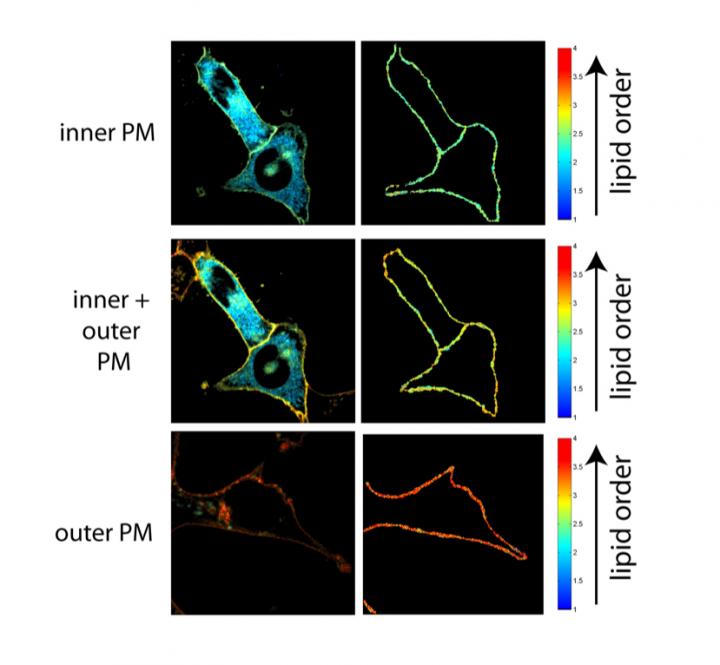

A cell's membrane is composed of a bilayer of lipids, and the inside-facing layer is made of different lipids than the outside-facing layer; the differences in membrane order between the inside and outside bilayer are both obvious and striking.
Credit: Joseph Lorent
A cell's membrane is its natural barrier between the inside of a cell and the outside world — composed of a double layer (bilayer) of lipids (such as fats, waxes, sterols, or fat-soluble vitamins). Intriguingly, it's been known for decades that the layer facing the inside of cells is made of different lipids than the outside-facing layer.
This “lipid asymmetry,” or lack of symmetry, is regulated via a variety of proteins and demands a high amount of energy from the cell. Since the cell invests resources toward keeping the lipids asymmetrically distributed equally between the two sides of the bilayer, the process is vital to its function. Dying cells, which permanently lose their lipid asymmetry, are targeted by the immune system for elimination.
Because different lipids create membranes with different physical properties, a group of McGovern Medical School researchers wondered whether different lipid compositions in the bilayer could also lead to different physical properties.
During the 62nd Biophysical Society Annual Meeting, held Feb. 17-21, in San Francisco, California, Joseph H. Lorent, a postdoctoral researcher, and Ilya Levental, an assistant professor, will present their work exploring lipid asymmetry's role in immune cell activation.
A variety of fluorescent probes can provide insights about the general physical properties of membranes. But these probes tend to stain both sides of the plasma membrane — making it impossible to independently measure the two layers of the bilayer.
“To overcome it, we use a trick where we inject the probe directly inside single cells using a tiny glass syringe like the kind used for extracting nuclei out of cells for cloning,” Lorent said. “This allows us to visualize specifically half of the membrane facing the [inside of the cell].”
Now the researchers could see the changes between the inside and outside bilayer. “The differences were obvious and striking,” Lorent said. “By preventing the loss of membrane asymmetry, we inhibited the immune response.”
The team found that adjusting the lipid asymmetry of the membrane was important to the immune cells functioning. “In the long run, by knowing how lipid asymmetry is involved in cell signaling, we might be able to 'tune' certain immune responses or even cell death through the regulation of lipid asymmetry,” Levental said. “This might involve treatments for allergies, inflammation or possibly even cancer.”
###
1873-Plat – “Structural determinants and functional consequences of protein association with membrane domains” is authored by Joseph Lorent, Blanca Barbara Diaz-Rohrer, Xubo Lin, Alex Gorfe, Kandice R. Levental and Ilya Levental. It will be presented at 11:45 a.m. PST Tuesday, Feb. 20, 2018, in South, Level Two, Room 215-216 of the Moscone Center, South. Abstract: https:/
MORE MEETING INFORMATION
ABOUT THE MEETING
Each year, the Biophysical Society Annual Meeting brings together more than 6,000 researchers working in the multidisciplinary fields representing biophysics. With more than 3,600 poster presentations, over 200 exhibits, and more than 20 symposia, the BPS Annual Meeting is the largest meeting of biophysicists in the world. Despite its size, the meeting retains its small-meeting flavor through its subgroup symposia, platform sessions, social activities and committee programs. The 62nd Annual Meeting will be held at the Moscone Center (South) in San Francisco, California.
PRESS REGISTRATION
The Biophysical Society invites professional journalists, freelance science writers and public information officers to attend its Annual Meeting free of charge. For press registration, contact Ellen Weiss at EWeiss@biophysics.org or the Media Line at the American Institute of Physics at media@aip.org or 301-209-3090.
NEWS RELEASES
Embargoed press releases describing in detail some of the breakthroughs to be discussed at the meeting are available on EurekAlert!, Newswise and Alpha Galileo or by contacting the Media Line at the American Institute of Physics at media@aip.org or 301-209-3090.
QUICK LINKS
Main Meeting Page: https:/
Symposia: https:/
Desktop Planner: http://www.
ABOUT THE SOCIETY
The Biophysical Society, founded in 1958, is a professional, scientific Society established to encourage development and dissemination of knowledge in biophysics. The Society promotes growth in this expanding field through its annual meeting, monthly journal, and committee and outreach activities. Its 9,000 members are located throughout the U.S. and the world, where they teach and conduct research in colleges, universities, laboratories, government agencies, and industry. For more information on the Society, or the 2018 Annual Meeting, visit http://www.












